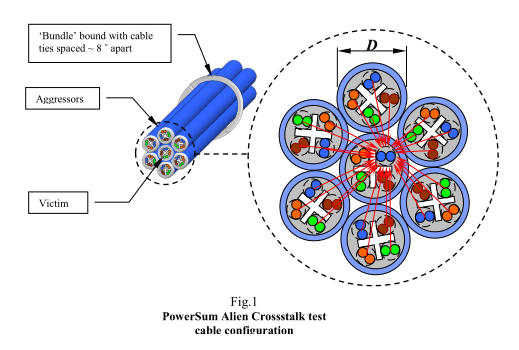
Hitachi Cable Manchester presents its white paper covering the background testing to determine effectiveness of EMI mitigation. Below is a summary of the main points you will find in the report.
With more and more consumer applications that require higher communication data rates (such as high definition video, etc.), copper cabling technologies that enable these data rates have been forced to evolve rapidly. New obstacles include minimization of the noise coupling within the internal components of the cable and noise coupling minimization involving other cables and external EMI sources.
Below you will find a summary of the most common method used to evaluate the effectiveness of EMI mitigation. You will also find a comparison between the two most common types of category cables used in telecommunications, unshielded twisted pair (UTP) & foil over unshielded twisted pair (F/UTP).
Background
The data rate capacity of a telecommunications cable is given primarily by its usable frequency range (bandwidth) and the Signal to Noise Ratio (SNR). As such, noise mitigation is crucial in the design of any telecommunications cable.
The most common method to achieve noise mitigation is through the twisting of the insulated wires into pairs, reducing the magnetic coupling of the signal. However, when a cable is installed in the vicinity of other EMI sources (i.e. other cables, electronic equipment, power lines, etc.) the twisting of the pairs is insufficient to guarantee performance, giving way to network disruptions.
Test Setup
To determine the difference in external noise mitigation between an overall shielded and an unshielded cable, an ANEXT (Alien Near End Crosstalk) test setup based on TIA/EIA 568-C.2 was used. For this test, one cable (known as victim) is surrounded by six similar cables (commonly referred to as aggressors). The aggressor cables are then energized, and the signal is measured in each pair of the victim cable (Fig. 1). In this case, Category 6A cable was chosen to evaluate.

Test Results
The results from the test show the noise mitigation of the F/UTP cable is almost 100% (barely any noise to be seen even at high frequencies). By comparison, in the UTP cable, the electromagnetic radiation (noise) from the other cables is evident in the complete frequency range. Differences in noise reception can be as high as 30 dB from mid to high frequencies with a minimum of 8 dB at low frequencies.
Conclusion
Regardless if the original planning of a UTP solution is adequate to provide the current desired network performance, the future performance and functioning of the system is unknown. Additional installations of EMI sources such as supplemental cables, power lines, high power circuits, etc. might cause the UTP solution network to fail. For this reason, the F/UTP solution will significantly increase the initial network performance as well as the future expectations of the network to function at the desired data rate level for a longer period of time.
For the full white paper including graphs of results from Hitachi, click here.


.png?width=58&height=58&name=X_logo_2023_(white).png)
